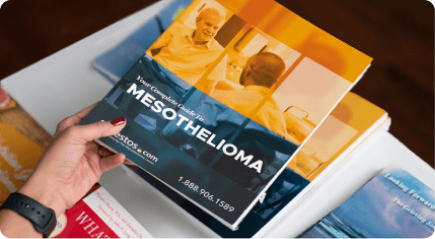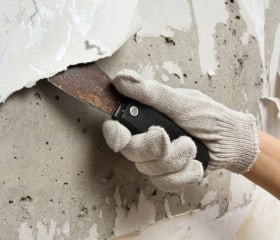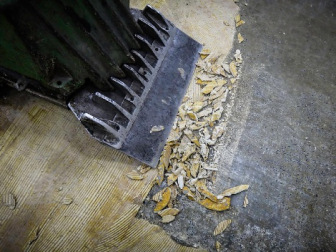
Asbestos in Vinyl Products
Many vinyl products were made with asbestos before the 1980s. Manufacturers added the mineral to vinyl wallpaper, siding, flooring and gaskets to boost their heat resistance. Some workers exposed to asbestos in vinyl products developed diseases such as mesothelioma.

Types of Vinyl Products That Contain Asbestos
Many brands of vinyl wallpaper, floor tiles, sheet flooring and old siding were made with asbestos for its durability and heat resistance. Some vinyl products didn’t contain asbestos but were contaminated with asbestos backings and adhesives.
Several manufacturers phased out using the mineral in their products as the public became more aware of the health risks associated with asbestos exposure. Older homes and buildings may still contain legacy asbestos vinyl products, and people may encounter them when salvage or vintage shopping.
Vinyl Products That Contained Asbestos
- Backing for flooring and wallpaper
- Floor tiles
- Gaskets
- Sheet flooring
- Siding
- Wallpaper
Some asbestos vinyl gaskets are still in use. However, the Biden administration in 2024 finalized the U.S. Environmental Protection Agency’s final rule banning ongoing uses of one specific type of asbestos, chrysotile, which “bans most sheet gaskets that contain asbestos.” Some gaskets used in nuclear power plants are allowed to continue to use asbestos for safety reasons, but these gaskets aren’t vinyl products.
Some people may worry their vinyl records contain asbestos. Production of vinyl records began in the 1930s when asbestos was heavily used in many industries. But asbestos wasn’t added to vinyl records. Early records from the late 19th and 20th centuries were lacquer. These lacquer records were made from asbestos and shellac.
Manufacturers and Brands of Asbestos Vinyl Products
Goodyear and Sears-Roebuck and other manufacturers have produced vinyl products containing asbestos for decades. Many of these companies made asbestos vinyl wallpaper and flooring.
People used these products in homes, schools and buildings across the country. Some companies also created more than one type of vinyl product with asbestos.
Manufacturers of Asbestos Vinyl Products
- American Biltrite
- Amtico Floors
- Armstrong World Industries
- Atlas Asbestos
- Bird Corporation
- Celotex Corporation
- Congoleum Corporation
- EverWear
- GAF Corporation
- Goodyear
- Johns Manville
- Kentile Floors
- Montgomery Ward
- Sears-Roebuck
Bird Corporation and Celotex Corporation produced asbestos vinyl siding. After Bird Corporation faced hundreds of asbestos lawsuits, it phased out asbestos in its products. Other companies faced lawsuits about asbestos exposure as well.
Many companies that went bankrupt as a result of lawsuits set up asbestos trust funds. These funds set aside money for future claims from those who developed an asbestos-related disease. An experienced attorney can help you determine if you’re eligible to file a trust fund claim or an asbestos lawsuit.


Health Risks of Asbestos in Vinyl Products
Damaged or aging vinyl products that contain asbestos can release tiny toxic fibers into the air. Inhaling asbestos fibers can cause them to stick in the lining of the lungs. This may lead to inflammation or scarring. Over time, this can cause diseases like mesothelioma, asbestosis or lung cancer.
Registered nurse and oncology writer at The Mesothelioma Center, Sean Marchese, says, “Asbestos fibers trapped in the body for long periods of time can damage cells. The DNA in those cells becomes damaged over time, which can lead to the formation of cancer.”
Studies show asbestos exposure can also happen from normal use of asbestos-containing vinyl products. For example, vinyl flooring can break down from normal wear and tear or maintenance, releasing asbestos fibers.
Who’s at Risk?
Those who have handled asbestos vinyl every day are most at risk for exposure and developing an asbestos-related disease. This particularly includes those who manufactured or installed vinyl asbestos products.
Today, those who still work with asbestos vinyl gaskets are at risk. People who maintain or remove legacy asbestos vinyl wallpaper, siding or flooring are also at a higher risk. This risk affects not only professionals but also do-it-yourself home renovators.
People at Risk of Asbestos Exposure
- Carpenters
- Construction workers
- Custodians and janitors
- Demolition crews
- DIY home renovators
- Floor and wallpaper installers
- Maintenance workers
- Vinyl factory workers
If you have a history of asbestos exposure, finding a doctor with experience with accurately diagnosing and treating diseases like mesothelioma and asbestos lung cancer can help. Finding signs of lung damage or the development of cancer early often affords patients more treatment options, resulting in better outcomes.
Compensation for Exposure to Asbestos Vinyl Products
Manufacturers have paid millions of dollars in mesothelioma compensation to plaintiffs in successful personal injury and wrongful death lawsuits. Most asbestos cases end in settlement before ever getting to trial. Compensation can help with lost income, medical bills, or other unexpected costs from an asbestos-related disease.
Notable Asbestos Vinyl Product Verdicts and Settlements
- $70.8 million verdict: A California jury awarded $70.8 million to U.S. Navy machinist Robert Whalen in 2014. He developed mesothelioma from exposure to vinyl components like John Crane gaskets and seals.
- $23 million verdict: In March 2024, a New York appeals court upheld a $23 million verdict awarded to a steamfitter who developed mesothelioma after asbestos exposure from Jenkins Bros. asbestos vinyl products such as gaskets.
- $2.58 million in settlements: A licensed contractor in New York received $2.58 million in settlements from several distributors and manufacturers of vinyl flooring and other products like ceiling tiles. The plaintiff, who installed flooring and other construction materials for drug stores across the state, developed mesothelioma after working for nearly a decade with asbestos-containing vinyl products.
The 2024 Mealey’s Litigation Report shows the average verdict for an asbestos lawsuit is $20.7 million. An average asbestos settlement ranges from $1 million to $2 million. Any compensation you might receive will depend on the details of your individual case. A mesothelioma attorney can help you file a claim and build a case if you’ve been exposed to asbestos in vinyl products.

Over $30 billion has been set aside to support those diagnosed with mesothelioma. We’ll help you explore your options and introduce you to the nation’s leading mesothelioma law firms.
Get Help NowIdentifying and Handling Asbestos Vinyl Wallpaper and Other Products

You can’t see asbestos in vinyl products such as flooring, wallpaper or siding. If you think a product has asbestos, call a licensed abatement professional for testing and removal. Licensed experts must follow all local, state and federal guidelines for asbestos disposal.
If removal isn’t possible, you can have asbestos encapsulated. This seals the materials and helps keep harmful fibers from becoming airborne. Encapsulation can be a cheaper option than removal. The encapsulation process uses spray or brush methods on materials that contain asbestos. This helps lower the risk of exposure. A trained professional must handle asbestos encapsulation.
DIY home renovation projects can expose you to asbestos. Removing older vinyl wallpaper, siding or flooring tiles can be risky. These projects can release harmful asbestos fibers into the air you and your family breathe.
Recommended Reading



